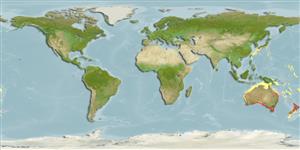Teleostei (teleosts) >
Pleuronectiformes (Flatfishes) >
Bothidae (Lefteye flounders)
Etymology: Lophonectes: Greek, lophos = crest + Greek, nekton = swimm (Ref. 45335).
More on author: Günther.
Environment: milieu / climate zone / depth range / distribution range
Ecology
Marine; demersal; depth range 26 - 240 m (Ref. 9563). Temperate
Western Pacific: eastern Australia (ranging south to South Australia and Tasmania, Ref. 9563) and New Zealand.
Size / Weight / Age
Maturity: Lm ? range ? - ? cm
Max length : 20.0 cm Tl male/unsexed; (Ref. 9824)
Dorsal spines (total): 0. Males with bony tubercles on snout and tip of lower jaw. Head tubercles weakly developed or absent in females. Anterior dorsal-fin rays greatly elongate in males (Ref 42535).
Usually found on sandy bottoms (Ref. 9824). Feeds on benthic animals (Ref. 9824).
Life cycle and mating behavior
Maturities | Reproduction | Spawnings | Egg(s) | Fecundities | Larvae
May, J.L. and J.G.H. Maxwell, 1986. Trawl fish from temperate waters of Australia. CSIRO Division of Fisheries Research, Tasmania. 492 p. (Ref. 9563)
IUCN Red List Status (Ref. 130435)
Threat to humans
Harmless
Human uses
Fisheries: of no interest
Tools
Special reports
Download XML
Internet sources
Estimates based on models
Preferred temperature (Ref.
123201): 13.4 - 23.3, mean 15.9 °C (based on 169 cells).
Phylogenetic diversity index (Ref.
82804): PD
50 = 0.7500 [Uniqueness, from 0.5 = low to 2.0 = high].
Bayesian length-weight: a=0.00912 (0.00408 - 0.02036), b=3.05 (2.87 - 3.23), in cm total length, based on LWR estimates for this (Sub)family-body shape (Ref.
93245).
Trophic level (Ref.
69278): 3.5 ±0.37 se; based on food items.
Resilience (Ref.
120179): Medium, minimum population doubling time 1.4 - 4.4 years (Preliminary K or Fecundity.).
Fishing Vulnerability (Ref.
59153): Low vulnerability (10 of 100).
